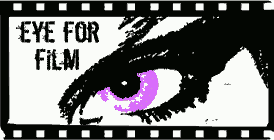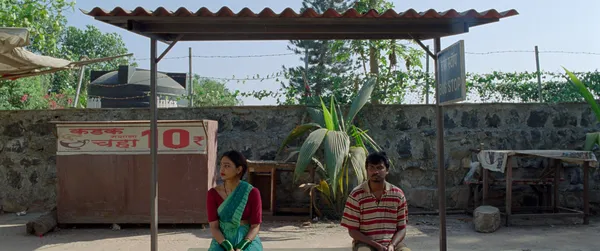 |
| Sister Midnight |
Indian artist and filmmaker Karan Kandhari's feature début, Sister Midnight, is a wildly imaginative and unpredictable black comedy. The story begins after the misanthropic Uma's (Rhadika Apte) arranged marriage to Gopal (Ashok Pathak). They set out to make a home in a small and claustrophobic Mumbai shack that offers little privacy. Lacking basic domestic skills, Uma has to seek advice from a neighbour, who she surprisingly befriends. Meanwhile, her half-witted husband tests her patience. Together, they share the misery of their awkward marriage, which takes an unexpected turn when Uma connects with the nocturnal city, and begins to exhibit strange behaviour.
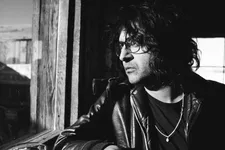 |
| Karan Kandhari |
Born in the Middle East before relocating to London in 1999, where he predominantly lives, Kandhari's previous credits include the short films Hard Hat, Flight of the Pompadour and Sidney. These form the United Howl trilogy, which revolves around the theme of misfits. He has also created works for bands including Franz Ferdinand, The Vaccines and Idlewild.
In conversation with Eye For Film, Kandhari discussed blurring genre boundaries, reaching back to punk music, the influence of Bob Dylan, and being drawn to misfits.
Paul Risker: Looking right the way back to your childhood, how would you describe your relationship to cinema?
Karan Kandhari: It's the art form I fell in love with at the earliest age, and as far as I can remember, this is all I ever wanted to do. I grew up for a little bit in the Middle East, and I guess we had these video shops, but we only had access to weird action movies and Hollywood films.
A mate of my dad's, who I found out was really into cinema, asked me, "Have you ever heard of the Nouvelle Vague?" I was like, "What is that?" So, every time he travelled to Europe for work, he would bring me back VHS tapes of [Jean-Luc] Godard and [François] Truffaut's films. I remember seeing Godard's Masculine Feminine, and it was like taking acid or something for the first time. My brain exploded, and I thought, 'Oh, my God, you can make films a different way.' I must have been around 15 years old, and so, that film had a massive impact.
PR: The cinema of the Nouvelle Vague, as well as directors like Luis Buñuel, were characterised by freedom of expression. Sister Midnight possesses this same spirit, prioritising playfulness with the cinematic language and form over obedience to rules.
KK: What people forget is how playful those films were, especially Godard's mid to late 60s stuff. It's playful in terms of humour, and it's playful in terms of cinematic form.
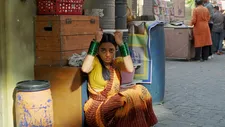 |
| Sister Midnight |
There's no golden rule to how a story should be told or structured, and if art doesn't surprise you when you experience it, then I don't see the point.
Without spoiling Sister Midnight, it takes and hopefully dismantles a well-worn character and genre archetype. It's a character that would usually be seen in a horror film, but I'm not interested in horror films, and the archetype doesn't have to be exclusive to one genre.
I guess my film is inconvenient. Part of why it took so long to get made is that it doesn't fit into a box, and it's very proud of that. I hope people can start breaking down these boundaries and blur them even further. The filmmaker who, in spirit, had the biggest impact on me because of what he did with genre or form, was Robert Altman. He was an anarchist when it came to filmmaking.
PR: If I were to choose one word to describe Sister Midnight, it would be metamorphosis.
KK: It's definitely that — you've hit the nail on the head. Stories of people metamorphosing are as old as time, and lots of folk heroes or tales of folk characters or folk outlaws are metamorphosis tales, because you find someone coming from unlikely backgrounds and bumping up against the world. Essentially, Sister Midnight is about somebody metamorphosing from being a small-town misfit into an accidental outlaw.
PR: In your films, you have been drawn to the outlaw, outcast and outsider, although in your director's statement you state that an outlaw is not a criminal, they are an outsider or folk hero. Why your interest in outlaws, outcasts and outsiders? Does it stem from personal experiences or even the films and filmmakers you've been drawn to?
 |
| Sister Midnight |
KK: I've felt like a misfit most of my life. I moved around so much, and so I'm from everywhere; nowhere. But yes, in terms of the art that I'm attracted to, whether it's film, poetry, painting, or music, which is my real love, I'm attracted to these people that exercise their own logic, and who are outlaws in their thinking. So, William S Burroughs, Sylvia Plath, Emily Dickinson, and William Blake. These are all people who made their impact by going against the grain and not conforming to the world's rigid expectations.
PR: You describe yourself as a misfit, and yet, Sister Midnight has generated a buzz, and people are gravitating to it.
KK: I can't wear my outsider badge if it's getting good reviews, right? [Laughs]
PR: The amusing irony is that those writers you mentioned are outsiders or outlaws, and yet they are literary figures with a significant following. I love these types of contradictions.
KK: John Waters and Divine are a great example of that, and they're two of my heroes.
PR: Watching Sister Midnight, I found myself thinking about Bob Dylan and various other artists who could create these larger-than-life narratives in their songs. If you tried to adapt some of Dylan's lyrics, it would come out as a surreal fever-like dream. I see a connection here with Sister Midnight. What Dylan and these other artists are doing through music, you're doing through cinema.
 |
| Sister Midnight |
KK: Well, it's funny you mention Bob Dylan because, in the weirdest way, he is the artist that feeds me the most. I'm an absolute Dylan nut. Hearing Stuck Inside of Mobile with the Memphis Blues Again, in the desert at the age of 15, was like taking a drug because these images were just so vivid. I want to make films how Dylan makes songs, or at least how his images appeared in the 60s — these images that explode like neutron bombs. It's actually so strange you mentioned this because there is an entire scene in Sister Midnight that comes from a Bob Dylan song.
I don't know if I can spoil it, but I'll recite the lyrics. It's from a sort of off cut that is a bit obscure. The song is called Drifter's Escape. I was listening to it because it's an outlaw ballad and at some point in the story, the outlaw is in court being tried. The lyrics go:
Just then a bolt of lightning
Struck the courthouse out of shape
And while everybody knelt to pray
The drifter did escape
I don't know if you can recall the scene I'm referring to in our film, but there's what appears to be a supernatural strike of lightning, and it freaks out a priest and a cop. That's where the whole scene came from.
PR: Much of the film, with its abruptness, may have been inspired by those lyrics. Audiences are programmed to want to clearly understand and identify the logical thread of a story, but Sister Midnight forces us out of our comfort zone. Instead, we have to keep up with the film, which is willing to leave us behind if we can't keep up. It can be empowering when cinema is willing to create that type of experience.
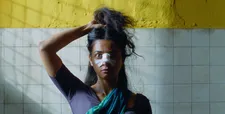 |
| Sister Midnight |
KK: The greatest example of that is David Lynch. He always talked about mystery being so important, and not mystery as a kind of aesthetic flavour, but mystery as a kind of narrative component. I'm very glad you picked up on that. It's insulting to spoon-feed the audience. Film is an audiovisual medium, which is why my film doesn't have that much dialogue. If we can use those two faculties intertwined, then that's the magic of storytelling through cinema.
PR: If Sister Midnight's dialogue is minimal and is not a narrative force, it still crackles. When discussing the film, it'll be difficult not to quote some of those memorable lines or verbal exchanges. These are so matter of fact, and early on Uma says something that warns us that it will be no holds barred dialogue.
KK: It's like going back to punk music, which is minimalist and based on repetition. Every time a slight change happens in a chord it's like a release. So, hopefully, dialogue, when it is used sparingly in this film, is like an impactful and literal explosion.
There's some sort of truth in the minimalism of a deadpan approach. That's the stuff I respond to the most, because it just cuts, and for me, humour is the highest form of art.
Sister Midnight is in UK and Irish cinemas from 14 March.
